

Morton Subotnick. The Renaissance Society at the University of Chicago Contemporary Art Museum: Peter Welz<br>in collaboration with William Forsythe, Whenever on on on nohow on. Peter Welz (Germany) is known for his kinetic investigations of the sculptural body.
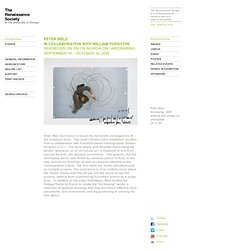
This multi-channel video installation resulted from a collaboration with Frankfurt-based choreographer William Forsythe (U.S.). The work begins with Forsythe transcribing the phrase 'whenever on on on nohow on," a fragment of text from Samuel Beckett, into physical movements. This gesture, and the developing dance, was filmed by cameras placed in front, to the side, and above Forsythe, as well as cameras attached to the choreographer's body. The five views are shown simultaneously on multiple screens. The experience is of an endless circle where the viewer chases both the phrase and the dance across the screens, without ever experiencing Forsythe's actions as a single form.
Tom's Song by Joanna Dudley. Sterneworks. IdeaPad Y410p High-Performance 14" Multimedia Laptop from Lenovo. DAW Labs - Buy a Laptop Computer for Recording Digital Audio. Offers PC Pro audio laptops for: Nuendo, Pro Tools, Sequoia, Samplitude, Cubase 5, Sonar 8, Ableton live. Album Notes: Music on a Long Thin Wire. I first got the idea for "Music on a Long Thin Wire" in 1977.

Physicist John Trefny and I were teaching a course on musical acoustics at Wesleyan and had set up a modern version of the Pythagorean monochord. We extended a short metal wire across a laboratory table and placed an electromagnet over one end of it. An audio oscillator drove the wire. The interaction between the flux field of the magnet and the frequency and loudness of the oscillator caused the wire to vibrate in ways observable to the naked eye. I was fascinated by this demonstration and started imagining what a very long monochord-one which could be installed on a concert stage or occupy a gallery space-would sound like. "Music on a Long Thin Wire" is constructed as follows: the wire is extended across a large room, clamped to tables at both ends. I played the wire several times as a solo piece and once as a duet with David Rosenboom in Toronto. Four separate recordings were made. Philip Corner explains minimalism music.
By Philip Corner(April 2012) All 'isms' are political snow-jobs, and in this case, a way of putting American economic power behind a nationalist program of professional opportunism, exactly as was done, for instance with "Action Painting" and "Pop-Art" (God help me, there have been gestures towards perpetrating the same with Fluxus- but we have been able to protect ourselves, by being failures!

Hahaha). The point here is that the use of severely restricted means, in the hope that "less is more. " In music, this would apply principally to the dimensions of space and time- that is, rhythm and pitch (colour and intensity have surely their relevance but can be considered more as affective procedures than structural). In one way or another, repetition will be of the essence, more effectively as the elements in play are simplified.
Philip Corner. About Lifeworkby Daniel Varela(August 2013) It all started in 1990 in Argentina, when I saw a small catalogue printed by Frog Peak composers' collective.
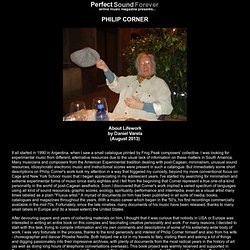
I was looking for experimental music from different, alternative resources due to the usual lack of information on these matters in South America. Many musicians and composers from the American Experimental tradition dealing with post-Cagean, minimalism, unusual sound resources, idiosyncratic electronic music and instructional scores were present in such a catalogue. But immediately some short descriptions on Philip Corner's work took my attention in a way that triggered my curiosity, beyond my more conventional focus on Cage and New York School music that I began appreciating in my adolescent years. Album Notes: Music on a Long Thin Wire. Philip Corner - Gong! (1974) Philip Corner explains minimalism music.
Perfect Sound Forever- Articles. Philip Corner. Album Notes: Music on a Long Thin Wire. Online music magazine. The Journal for Ancient Performance. By Thanos Vovolis Mask/Costume/Set Designer, Visiting Professor, Dramatic Institute, Stockholm.
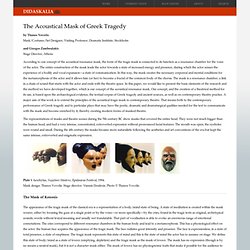
Pyramid at Resonance. Orion Infrasound Pyramid at Resonance The limestone blocks of the Orion pyramids consist of mostly calcite mineral, whose structure can be triangular and octahedral in various forms.

Each of the Giza pyramids is apparently designed as the top half of an octahedron, monumental formations of calcite. The angular mathematics of the Orion pyramidal design will be addressed shortly, but their limestone blocks contain information regarding the construction methods of the pyramid builders. Research of J. Davidovits into ancient geopolymers has demonstrated through chemical X-ray analysis that the casing stones of the Giza pyramids are synthetic, being of lower density than any quarried stone due to trapped air bubbles and consisting of 85-90% calcite with other exotic mineral constituents like opal CT, hydroxy-apatite and silico-aluminates. Diverse new technologies have incorporated fractal patterning for signal enhancement, data compression and encryption. Poème électronique: Le Corbusier, Edgard Varèse & Xenakis collaborate, 1958. The Philips Pavilion was a World’s Fair pavilion, part of Expo ‘58 in Brussels and was designed by the office of Le Corbusier.
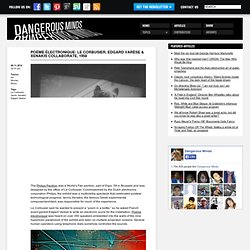
Commissioned by the Dutch electronics corporation Philips, the exhibit was a multimedia spectacle that celebrated postwar technological progress. Iannis Xenakis, the famous Greek experimental composer/architect, was responsible for much of the experience. Le Corbusier said he wanted to present a “poem in a bottle,” so he asked French avant gardist Edgard Varèse to write an electronic score for the installation. Poème électronique was heard on over 350 speakers embedded into the walls of the nine hyperbolic paraboloid of the exhibit and seen on multiple projection screens. Several human operators using telephone dials somehow controlled the sounds. Web Sound - Christopher DeLaurenti.
Sound. About UbuWeb Sound Originally focusing on Sound Poetry proper, UbuWeb's Sound section has grown to encompass all types of sound art, historical and contemporary.

Beginning with pioneers such as Guillaume Apollinaire reading his "Calligrammes" in 1913, and proceeding to current practitioners such as Vito Acconci or Kristin Oppenheim, UbuWeb Sound surveys the entire 20th century and beyond. Web Sound - Edgard Varèse. Edgard Varèse (1883-1965) Edgard Varèse Conducts a Jazz Workshop (1957) From WFMU's Beware of the Blog Edgard Varèse conducts a workshop with jazzmen Art Farmer (trumpet), Hal McKusik (clarinet, alto sax), Teo Macero (tenor sax), Eddie Bert (trombone), Frank Rehak (trombone), Don Butterfield (tuba), Hall Overton (piano), Charlie Mingus (bass), Ed Shaughnessy (drums), probably John La Porta (alto sax)...
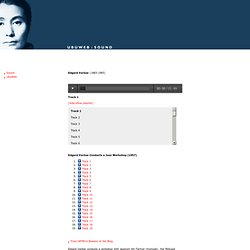
We don't know who is on vibes... Into The Music - The Clout of Edgard Varèse’s ‘Ionisation’ Yet the piece — to be performed by members of the at Avery Fisher Hall on Tuesday evening as part of a two-day Lincoln Center Festival series devoted to Varèse’s complete surviving output — is genuinely groundbreaking.

Varèse (1883-1965) fashioned a rigorously organized discourse for 13 percussionists playing on 40 instruments, and nothing else. Other composers wrote solely for percussion before Varèse composed “Ionisation” from 1929 to ’31, but none with his sophistication and subtlety. Nicolas Slonimsky, the historian and composer to whom Varèse dedicated “Ionisation,” showed that the piece adhered to conventional sonata form, with two principal themes, contrasting subjects and sections of development and recapitulation. But Varèse’s use of timbre, texture and density, rather than melody and harmony, as organizational tools pointed the way toward more radical future propositions like musique concrète and electronic music. Mr. Edgard Varese - Ionisation. The Stratospheric Colossus of Sound: Meet Frank Zappa’s mentor, Edgard Varèse.